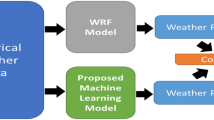Abstract
The volume and complexity of weather data, along with missing values and high correlation between collected variables, make it challenging to develop efficient deep learning frameworks that can handle data with more features. This leads to a lack of accurate and predictable weather forecasts. To develop a hybrid deep learning framework for weather forecast with rainfall prediction using weather big data analytics to ensure high detection rates. A modified planet optimization (MPO) algorithm is used for data preprocessing to remove unwanted artifacts. An improved Tuna optimization (ITO) algorithm is presented to select optimal features to avoid data dimensionality issues. A hybrid memory-augmented artificial neural network (MA-ANN) classifier is developed to improve weather early forecast detection rates. The proposed framework is validated against standard benchmark datasets such as weather underground and climate forecast system reanalysis (CFSR). The simulation results are compared with other existing state-of-the-art frameworks based on error measures (RMSE, MAPE, BIAS, R) and quality measures (accuracy, sensitivity, specificity, precision, F1-measure).The MA-ANN classifier accuracy obtained 97.65% for wunderground.com Delhi and 98.88% for Tamilnadu. The hybrid deep learning framework with rainfall prediction using weather big data analytics has shown promising results for accurate and predictable weather forecasts. The proposed framework outperforms other existing state-of-the-art frameworks, and the MA-ANN classifier has improved weather early forecast detection rates. The study demonstrates the potential of utilizing big data techniques in weather forecasting and highlights the importance of develo** efficient deep learning frameworks to handle complex and high-dimensional weather data.






Similar content being viewed by others
Data availability
Data sharing not applicable to this article as no datasets were generated or analyzed during the current study.
References
Abebe WT, Endalie D (2023) Artificial intelligence models for prediction of monthly rainfall without climatic data for meteorological stations in Ethiopia. J Big Data 10(1):2
Sittaro F, Hutengs C, Vohland M (2023) Which factors determine the invasion of plant species? Machine learning based habitat modelling integrating environmental factors and climate scenarios. Int J Appl Earth Obs Geoinf 116:103158
Benti NE, Chaka MD, Semie AG (2023) Forecasting renewable energy generation with machine learning and deep learning: Current advances and future prospects. Sustainability 15(9):7087
Brun P, Thuiller W, Chauvier Y, Pellissier L, Wüest RO, Wang Z, Zimmermann NE (2020) Model complexity affects species distribution projections under climate change. J Biogeogr 47(1):130–142
Jafseer KT, Shailesh S, Sreekumar A (2023) A feature evolution aware classification framework for streaming data using dynamic autoencoder and ensembled learning. https://doi.org/10.21203/rs.3.rs-2479805/v1
Goswami S, Kumar A (2023) BiLSTM_SAE: a hybrid deep learning framework for predictive data analytics system in traffic modeling. https://doi.org/10.21203/rs.3.rs-2422617/v1
Osipov A, Pleshakova E, Gataullin S, Korchagin S, Ivanov M, Finogeev A, Yadav V (2022) Deep learning method for recognition and classification of images from video recorders in difficult weather conditions. Sustainability 14(4):2420
Merabet K, Heddam S (2023) Improving the accuracy of air relative humidity prediction using hybrid machine learning based on empirical mode decomposition: a comparative study. Environ Sci Pollut Res 30:60868–60889. https://doi.org/10.1007/s11356-023-26779-8
Carrera B, Sim MK, Jung JY (2020) PVHybNet: A hybrid framework for predicting photovoltaic power generation using both weather forecast and observation data. IET Renew Power Gener 14(12):2192–2201
Kumar B, Abhishek N, Chattopadhyay R, George S, Singh BB, Samanta A, Singh M (2021) Deep learning based forecasting of Indian summer monsoon rainfall. Algorithms 9(11):13. https://doi.org/10.48550/ar**v.2107.04270
Sen S, Saha S, Chaki S, Saha P, Dutta P (2021) Analysis of PCA based adaboost machine learning model for predict mid-term weather forecasting. Comput Intell Mach Learn 2(2):41–52
Wei CC, Chou TH (2020) Typhoon quantitative rainfall prediction from big data analytics by using the apachehadoop spark parallel computing framework. Atmosphere 11(8):870
Vuyyuru VA, Rao GA, Murthy YS (2021) A novel weather prediction model using a hybrid mechanism based on MLP and VAE with fire-fly optimization algorithm. Evol Intel 14:1173–1185
Jeong CH, Yi MY (2023) Correcting rainfall forecasts of a numerical weather prediction model using generative adversarial networks. J Supercomput 79(2):1289–1317
Zhou K, Zheng Y, Li B, Dong W, Zhang X (2019) Forecasting different types of convective weather: A deep learning approach. J Meteorol Res 33(5):797–809
Deo RC, Şahin M (2015) Application of the artificial neural network model for prediction of monthly standardized precipitation and evapotranspiration index using hydrometeorological parameters and climate indices in eastern Australia. Atmos Res 161:65–81
Roesch I, Günther T (2019) Visualization of neural network predictions for weather forecasting. Comput Graph Forum 38(1):209–220
Saha M, Santara A, Mitra P, Chakraborty A, Nanjundiah RS (2021) Prediction of the Indian summer monsoon using a stacked autoencoder and ensemble regression model. Int J Forecast 37(1):58–71
Dharavath R (2021) DSSAE-BBOA: deep learning-based weather big data analysis and visualization. Multimed Tools Appl 80(18):27471–27493
Author information
Authors and Affiliations
Corresponding author
Ethics declarations
Conflict of interest
Dear Editor
I have no conflict of interest.
Additional information
Publisher's Note
Springer Nature remains neutral with regard to jurisdictional claims in published maps and institutional affiliations.
Rights and permissions
Springer Nature or its licensor (e.g. a society or other partner) holds exclusive rights to this article under a publishing agreement with the author(s) or other rightsholder(s); author self-archiving of the accepted manuscript version of this article is solely governed by the terms of such publishing agreement and applicable law.
About this article
Cite this article
Lalitha, C., Ravindran, D. Hybrid deep learning framework for weather forecast with rainfall prediction using weather bigdata analytics. Multimed Tools Appl (2024). https://doi.org/10.1007/s11042-023-17801-9
Received:
Revised:
Accepted:
Published:
DOI: https://doi.org/10.1007/s11042-023-17801-9




